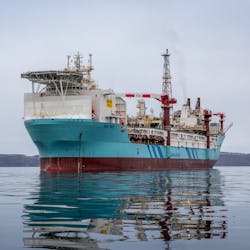Lancaster FPSO managing increased water cut
Offshore staff
GODALMING, UK – Hurricane Energy has issued a progress report on its early production system on the Lancaster oil field west of Shetland.
This is the first attempt by any operator to produce oil from a fractured basement field in UK waters. The two subsea wells are tied back to the FPSO Aoka Mizu.
After completing a prolonged individual flow test on the 205/21a-6 well at the end of January, Hurricane reverted to producing from both wells at progressively increasing rates in February.
Last month, combined production was increased to around 20,000 b/d of oil, with around 6,000 b/d of water, mainly from the 205/21a-7Z well.
Overall water cut for 1Q was around 17%, said to be well within the capacity of the FPSO’s water handling facilities.
Hurricane added that the production rates had been achieved without the use of electrical submersible pumps and with the wells choked back to less than 50%, confirming their high productivity.
Chief executive Dr Robert Trice cautioned: “The Lancaster EPS is still very much in a data gathering phase, as we continue to better our understanding of this unique basement reservoir. Further testing at the current rates will be required before any trends can be confirmed and conclusions made about the long-term behavior of the reservoir.
“Once trends have been established, it is anticipated that alternative combinations of well rates may be tested in order to establish the optimum long-term production configuration for the two wells.”
Although water production has risen markedly since start-up of the EPS, the data supports the company’s perched water model, he added.
Hydrocarbons started flowing through the FPSO on May 11, 2019.
04/15/2020
